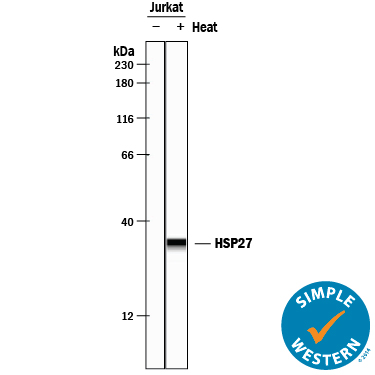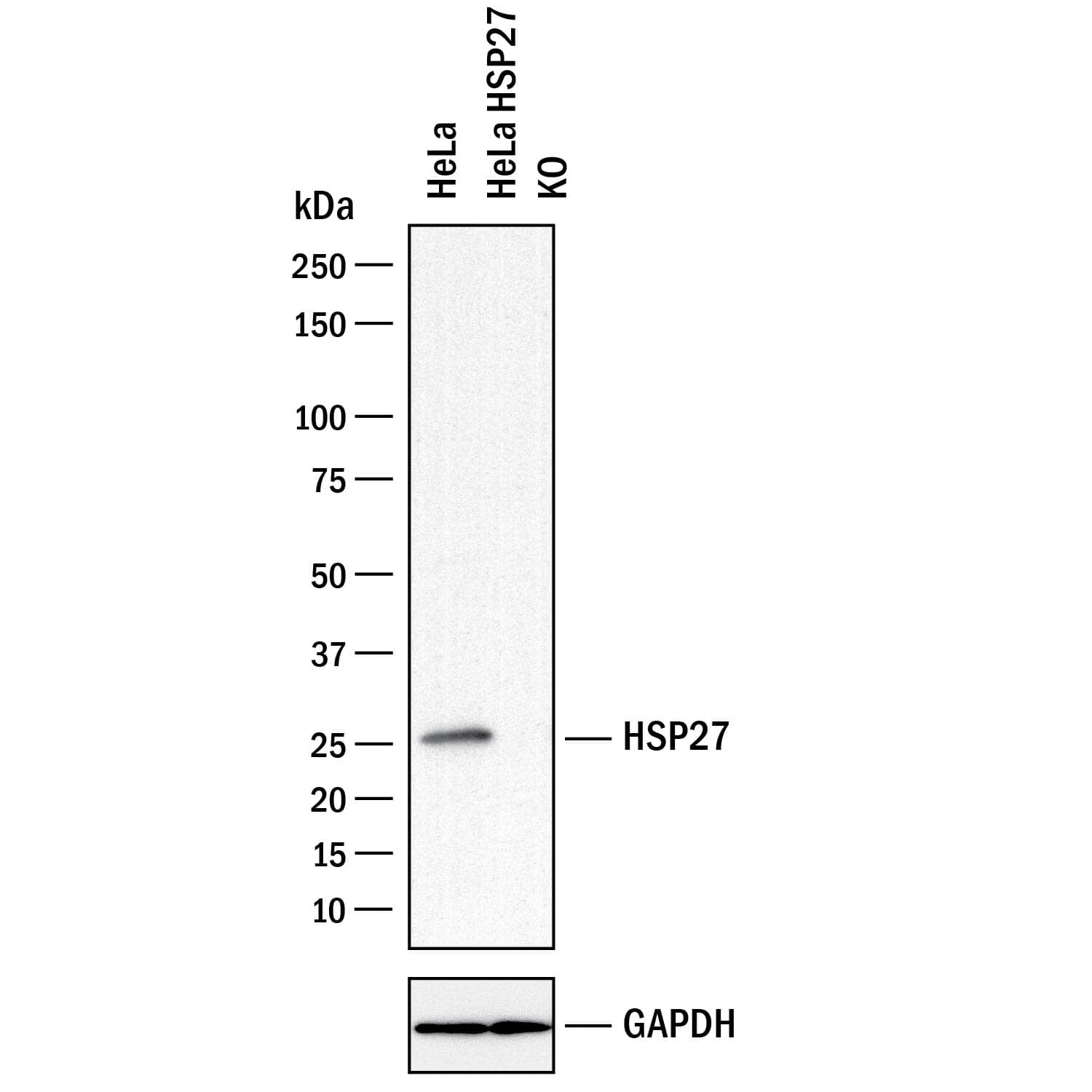Human/Mouse/Rat HSP27 Antibody
R&D Systems, part of Bio-Techne | Catalog # AF15801

Key Product Details
Validated by
Species Reactivity
Validated:
Cited:
Applications
Validated:
Cited:
Label
Antibody Source
Product Specifications
Immunogen
Thr2-Lys205
Accession # P04792
Specificity
Clonality
Host
Isotype
Scientific Data Images for Human/Mouse/Rat HSP27 Antibody
Detection of Human and Mouse HSP27 by Western Blot.
Western blot shows lysates of Jurkat human acute T cell leukemia cell line and NIH-3T3 mouse embryonic fibroblast cell line untreated (-) or treated (+) with a 42 °C heat shock for 30 minutes with a 3 hour recovery. PVDF membrane was probed with 0.1 µg/mL of Goat Anti-Human/Mouse/Rat HSP27 Antigen Affinity-purified Polyclonal Antibody (Catalog # AF15801), followed by HRP-conjugated Anti-Goat IgG Secondary Antibody (Catalog # HAF109). A specific band was detected for HSP27 at approximately 27 kDa (as indicated). This experiment was conducted under reducing conditions and using Immunoblot Buffer Group 2.Detection of Human HSP27 by Simple WesternTM.
Simple Western lane view shows lysates of Jurkat human acute T cell leukemia cell line, loaded at 0.2 mg/mL. A specific band was detected for HSP27 at approximately 33 kDa (as indicated) using 5 µg/mL of Goat Anti-Human/Mouse/Rat HSP27 Antigen Affinity-purified Polyclonal Antibody (Catalog # AF15801) followed by 1:50 dilution of HRP-conjugated Anti-Goat IgG Secondary Antibody (Catalog # HAF109). This experiment was conducted under reducing conditions and using the 12-230 kDa separation system.Western Blot Shows Human HSP27 Specificity by Using Knockout Cell Line.
Western blot shows lysates of HeLa human cervical epithelial carcinoma parental cell line and HSP27 knockout HeLa cell line (KO). PVDF membrane was probed with 0.5 µg/mL of Goat Anti-Human/Mouse/Rat HSP27 Antigen Affinity-purified Polyclonal Antibody (Catalog # AF15801) followed by HRP-conjugated Anti-Goat IgG Secondary Antibody (Catalog # HAF017). A specific band was detected for HSP27 at approximately 27 kDa (as indicated) in the parental HeLa cell line, but is not detectable in knockout HeLa cell line. GAPDH (Catalog # MAB5718) is shown as a loading control.This experiment was conducted under reducing conditions and using Immunoblot Buffer Group 1.Applications for Human/Mouse/Rat HSP27 Antibody
Knockout Validated
Simple Western
Sample: Jurkat human acute T cell leukemia cell line
Western Blot
Sample: 42° C heat shock-treated Jurkat human acute T cell leukemia cell line and NIH-3T3 mouse embryonic fibroblast cell line
Reviewed Applications
Read 2 reviews rated 4 using AF15801 in the following applications:
Formulation, Preparation, and Storage
Purification
Reconstitution
Formulation
Shipping
Stability & Storage
- 12 months from date of receipt, -20 to -70 °C as supplied.
- 1 month, 2 to 8 °C under sterile conditions after reconstitution.
- 6 months, -20 to -70 °C under sterile conditions after reconstitution.
Background: HSP27
Heat shock proteins (HSPs) are a family of highly conserved stress response proteins. Heat shock proteins function primarily as molecular chaperones by facilitating the folding of other cellular proteins, preventing protein aggregation or targeting improperly folded proteins to specific degradative pathways. HSPs are typically expressed at low levels under normal physiological conditions but are dramatically up-regulated in response to cellular stress. Elevated levels of HSPs have been observed in association with ischemia/reperfusion, cancer, and chronic heart failure. HSP27, also known as HSPB1, is a member of the small heat shock protein family, which also includes HSP25 and the alpha-crystallins. HSP27 forms a large oligomer and the extent of phosphorylation plays a role in determining specific functions. HSP27 also functions as an anti-apoptotic molecule, regulating apoptosis through direct interaction with key components of the apoptotic pathway. HSP27 binds and sequesters cytochrome c released from the mitochondria in response to an apoptotic stimulus. This prevents the proper assembly of the apoptosome and subsequently, the activation of procaspase-9 and procaspase-3.
References
- Gusev, N.B. et al. (2002) Biochemistry (Moscow) 67:511.
- Garrido, C. et al. (2001) Biochem. Biophys. Res. Commun. 286:433.
- Garrido, C. (2002) Cell Death Diffr. 9:483.
- Brvey, J-M. et al. (2000) Nat. Cell Biol. 2:645.
Long Name
Alternate Names
Gene Symbol
UniProt
Additional HSP27 Products
Product Documents for Human/Mouse/Rat HSP27 Antibody
Product Specific Notices for Human/Mouse/Rat HSP27 Antibody
For research use only


